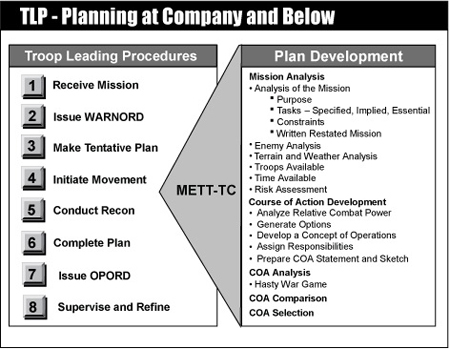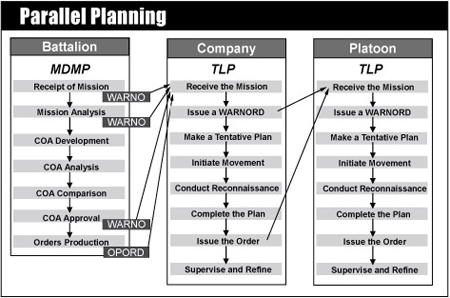Troop leading procedures (TLPs) extend the military decision-making process (MDMP) to the small-unit level. The MDMP and TLP are similar but not identical. They are both linked by the basic Army problem-solving process. Commanders with a coordinating staff use the MDMP as their primary planning process. Company-level and smaller units lack formal staffs and use TLP to plan and prepare for operations. This places the responsibility for planning primarily on the commander or small-unit leader.

Troop leading procedures are a dynamic process used by small-unit leaders to analyze a mission, develop a plan, and prepare for an operation (ADP 5-0). These procedures enable leaders to maximize available planning time while developing effective plans and preparing their units for an operation.
Leaders typically perform TLP while working alone or with a small group to solve tactical problems. For example, a company commander may use the executive officer, first sergeant, fire support officer, supply sergeant, and communications sergeant to assist during TLP.
The type, amount, and timeliness of information passed from a higher echelon to a lower echelon headquarters directly impacts the lower unit leader’s TLP.
Parallel Planning (with Higher Headquarters)

The type, amount, and timeliness of information passed from higher to lower headquarters directly impact the lower unit leader’s TLP. The solid arrows depict when a higher headquarters’ planning event could start TLP of a subordinate unit. However, events do not always occur in the order shown. For example, TLP may start with receipt of a warning order (WARNORD), or they may not start until the higher headquarters has completed the MDMP and issues an operation order (OPORD). WARNORD’s from higher headquarters may arrive at any time during TLP. Leaders remain flexible. They adapt TLP to fit the situation rather than try to alter the situation to fit a preconceived idea of how events should flow.
Editor’s note: Army leaders employ several methodologies for planning, determining the appropriate mix based on the scope and understanding of the problem, time available, and availability of a staff. Army planning methodologies include the Army design methodology (ADM), military decision-making process (MDMP), troop leading procedures (TLP), rapid decision-making and synchronization process (RDSP), and Army problem solving. All five planning methodologies are discussed in The Battle Staff SMARTbook.
 This article is an extract from "BSS7: The Battle Staff SMARTbook, 7th Ed. (Planning & Conducting Multidomain Operations)" by The Lightning Press. Download a free PDF sample and learn more at: BSS7: The Battle Staff SMARTbook, 7th Ed. (Planning & Conducting Multidomain Operations).
This article is an extract from "BSS7: The Battle Staff SMARTbook, 7th Ed. (Planning & Conducting Multidomain Operations)" by The Lightning Press. Download a free PDF sample and learn more at: BSS7: The Battle Staff SMARTbook, 7th Ed. (Planning & Conducting Multidomain Operations).
Browse additional military doctrine articles in our SMARTnews Blog & Resource Center.
About The Lightning Press SMARTbooks. Recognized as a “whole of government” doctrinal reference standard by military, national security and government professionals around the world, SMARTbooks comprise a comprehensive professional library. SMARTbooks can be used as quick reference guides during operations, as study guides at education and professional development courses, and as lesson plans and checklists in support of training. Browse our collection of Military Reference SMARTbooks to learn more.













































